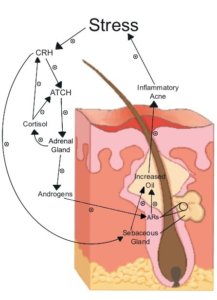We see it every day – the models in the media with gorgeous skin, smooth as can be, and zero imperfections. We are constantly absorbing unrealistic beauty standards of skin, which can lead to chronic stress about living up to those standards. What can we do if this stress and anxiety build into a cascade where it causes more skin outbreaks?
It is a vicious cycle that occurs repeatedly, and in the end, you are left with the question, “WHY?” Typically, when we think about anxiety, we think about heart palpitations, tremors, and that deep sense of panic. It seems like acne would be the last symptom that would be expressed as a result of anxiety – but it can be a cause of unexplained repeat breakouts. Let’s dive into the interconnected relationship between stress and skin.
Getting To the Root Cause
What Is the Relationship Between Acne, Stress, and Hormones?
It is fairly common knowledge that anxiety has an effect on our hormones, but it’s not often considered that this can result in dermatoses, or “disease of the skin.”
Cutaneous hyperandrogenism (CHA) is a skin condition where hormones cause skin changes such as acne, hirsutism, seborrhea, and androgenetic alopecia. One of the most common hormonal culprits of acne is androgens like testosterone and DHEA. What’s even more interesting is that your androgens may be responsible for your acne, even if your hormone testing is normal.
There are two reasons this may happen: The first relates to how your skin processes androgen enzymes. If you experience an “over-expression of the androgenic enzymes” in your skin, you will be at an increased risk of hormone-related acne. The second variable is the sensitivity of your skin’s androgen hormone receptors. If your receptors are overly responsive to the presence of androgens, you will be at a higher risk of hormone-related acne (Shrivastava, et al., 2018).
Your hair follicles and the sebaceous glands within are equipped with the necessary enzymes and receptors to make and metabolize androgens on their own. This process is essential for natural hair growth. Because of this ability, an associated misfortune is acne. We typically see the expression of androgen-mediated acne being most common in the 12-24 years old age group due to the vast hormonal changes that are happening in that season of life. However, this acne-causing process can affect anyone and everyone, and can especially be worsened by stress.
This mechanism by which this happens begins with the hypothalamic-pituitary axis (HPA) (See image). This axis plays an incredibly crucial role in moderating the fight or flight response. When the brain senses stress, it triggers the hypothalamus to respond by secreting corticotropin-releasing hormone (CRH). There are two things that occur as a result of this hormone secretion.

First, CRH binds to the anterior pituitary gland, causing the release of adrenocorticotropic hormone (ACTH). ACTH then calls on the adrenal glands to respond and secrete two key hormones: androgens and cortisol.
Let’s start with the androgens: the skin receives androgen hormone signals at a type of receptor, called Androgen Receptors (ARs). These are located in every cell of your body, including the sebocytes (oil cells) in your face. The increased activity of these receptors triggers an overproduction of sebum within the pilosebaceous unit, a hair follicle and its oil gland.
The second thing that is secreted from the adrenal gland is cortisol, otherwise known as “the stress hormone.” Cortisol is trying to get the body back to its normal state and works to provide negative feedback to both the hypothalamus and the anterior pituitary gland to stop them from secreting their respective hormones (Allen, Sharma, 2020). Cortisol will release for hours after the initial stress trigger, but if the stress stimulus is chronic, cortisol can never catch up.
The other notable thing that happens with the release of CRH is that it directly binds to sebaceous glands, resulting in more oil production.
“Expression of the complete CRH system is abundant in acne-involved skin, especially in the sebaceous glands, possibly activating pathways which affect immune and inflammatory processes leading to the development and stress-induced exacerbation of acne” (Ganceviciene, et al., 2009).
The excess oil that is produced on two different pathways as a result of CRH, causes the pores in your face to get clogged with dead skin cells and oil. This environment becomes a feeding ground for the bacteria which live on your skin called “cutibacterium acne.” As the bacteria multiply, the pore becomes inflamed, and acne emerges.
Then when we notice the imperfections on our skin, it triggers more stress and the cycle repeats itself.
Quick Solutions for Right Now
Now that we have reviewed the mechanism in which cutaneous hyperandrogenism occurs, let’s consider some options to combat these unwanted outbreaks. To do this, we have to figure out a way to slow down the response at the androgen receptors and balance the dysregulation of the hormone microenvironment. We can achieve this topically with plant medicine!
Topical Herbs
One plant that I love for its antiandrogenic effects is saw palmetto (Serenoa repens). It is a fruity-smelling oil full of greatness for your pores. The fat-soluble extract from the berry contains between 85 and 95 percent of free fatty acids and sterols. These compounds help to keep the skin nourished and reduce irritation. They act by blocking the 5-alpha reductase pathway, slowing down the conversion of testosterone into dihydrotestosterone (DHT). DHT is a hormone that can contribute to acne. Saw palmetto also has an abundance of antioxidants, which makes it protective against oxidative stress, supporting the health and appearance of your skin (Reddy, et al., 2017).
Another herb that is beneficial for cutaneous hyperandrogenism is green tea (Camellia sinensis). Its main active antiandrogenic component is epigallocatechin gallate (EGCG). Just like saw palmetto, it is an antagonist of androgen action via the 5-alpha reductase pathway. Not only is green tea antiandrogenic, but it is also full of vitamins B2 and E. These vitamins are very important ingredients in many cosmetic products for a few reasons. Vitamin B2 makes your skin more radiant and helps balance your skin’s natural oils; something that can be helpful to CHA caused by stress. Additionally, vitamin E has antioxidant properties, and it promotes wound healing. This is a great herb to keep your skin looking youthful, as well as slow down androgen receptor activity (Pazyar, et al., 2012).
Finally, the last herb I recommend for antiandrogenic effects is Chinese peony root (Paeonia lactiflora). This herb is useful in a few ways for CHA because of its main constituent, paeoniflorin. Paeoniflorin is useful for androgen-related acne due to its inhibition of the conversion of testosterone to DHT, as well as its ability to increase the activity of aromatase, the enzyme that turns testosterone into estrogen. This leads to less availability of androgens and less activity at the ARs.
The second skin benefit to paeoniflorin is that it is known to heal and reduce post-inflammatory hyperpigmentation in the skin. You know those dark spots that sometimes linger after a pimple heals? It can be daunting thinking about permanent acne damage. Fear not; Chinese peony root is an amazing rescue remedy for this (Qiu, et al., 2016) (Grant, Ramasamy, 2012)!
Now let’s formulate a personalized mixture designed to reduce stress-induced acne.
Facial Toner
When caring for acne, a very important aspect is your skin care routine. First and foremost, do not over-cleanse. When it comes to skin care, less is usually more. If you over-cleanse, it might dry out your skin and encourage oil production which is not ideal for acne.
When you are gearing up to begin your facial cleansing routine, gently wash your face with the cleanser you find to be most effective for your skin. Then pat your face dry, and end your routine with a spritz or two of this at-home botanical facial toning spray.
This spray is light, moisturizing, and is formulated to help with androgen receptor activity.
How to make your at-home facial toner:
- 50% Aloe Water (1 tablespoon aloe gel, 4 oz of water, blend until smooth)
- 16.6% Saw Palmetto Liquid Extract
- 16.6% Green Tea Liquid Extract
- 16.6% Peony Root Liquid Extract
If you were to make a three-ounce bottle, this might look like 1.5 ounces of aloe water, and a half-ounce of each herbal extract respectively. Give it a good shake before each application to make sure you’re getting the most out of the amazing herbs within!
If you are wondering where to even begin getting your hands on these herbal extracts, each of them can be found online through a simple search!
You Are Your Own Best Advocate
If there is one thing that you take away from reading this, I hope you know that you are your own best advocate. Each provider that you seek out for help truly desires to get the best results, but that outcome doesn’t always come to fruition. If that does happen, you have to remind yourself that you know your body best, and you are the only one who has the capabilities to keep the healing hope alive. Whether your advocacy looks like making an at-home facial toner, doing some meditation for stress relief, or giving an entirely new option a try, my favorite way to manage stress and anxiety is outlined step-by-step in the Anxiety Breakthrough Program, which you can access here. Keep fighting for that part of you who wants to get to the bottom of their health concerns.
Sometimes, the answer is not always as simple as “you have acne.” Whether it’s stress, hormones, food allergies, cosmetic products, or another potential root cause, it is of the utmost importance to explore all possible avenues and look at the body as a unit working together to get to the answer.
 Antibiotics are often the go-to solution for dermatologists when treating skin conditions such as acne and eczema. There are a number of reasons that relying on these prescriptions poses a problem.
Antibiotics are often the go-to solution for dermatologists when treating skin conditions such as acne and eczema. There are a number of reasons that relying on these prescriptions poses a problem. Millions of women use birth control pills as contraception, but some doctors prescribe The Pill to treat acne as well. Hormonal contraceptives, while effective at preventing unintended pregnancy, may cause health issues. After all, by their very nature, they throw off the hormones cortisol and testosterone. What’s more, they may cause nutritional deficiencies.
Millions of women use birth control pills as contraception, but some doctors prescribe The Pill to treat acne as well. Hormonal contraceptives, while effective at preventing unintended pregnancy, may cause health issues. After all, by their very nature, they throw off the hormones cortisol and testosterone. What’s more, they may cause nutritional deficiencies.